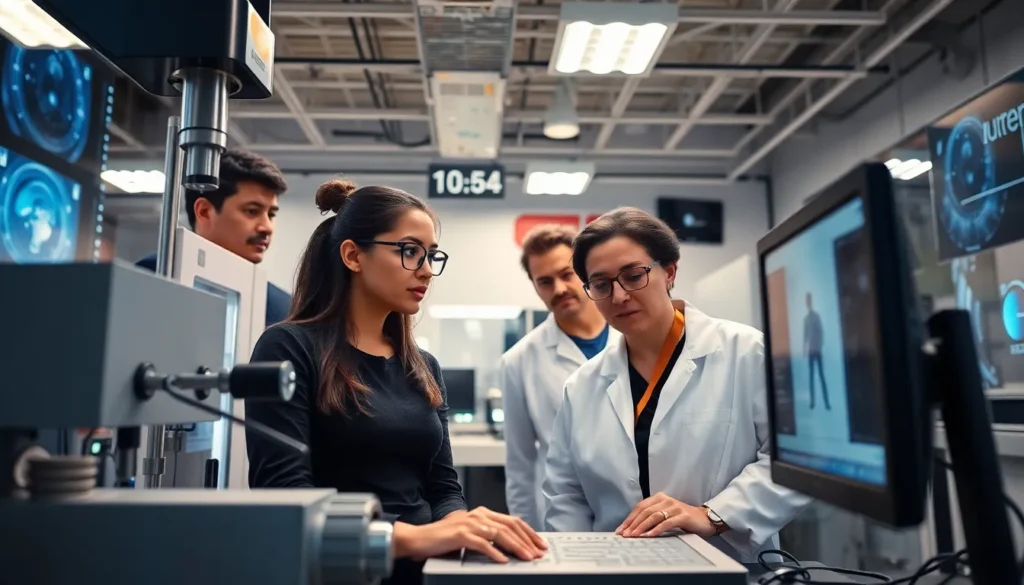Table of Contents
ToggleIn a world where every scratch and dent can lead to a catastrophic failure, precision damage testing is the hero we didn’t know we needed. Imagine a meticulous detective, magnifying glass in hand, scrutinizing every tiny flaw in a product’s armor. This isn’t just about aesthetics; it’s about ensuring safety and reliability in everything from aerospace to consumer electronics.
With stakes this high, precision damage testing isn’t just a nice-to-have; it’s a must-have. Companies are discovering that investing in this process can save them from costly recalls and reputational disasters. Plus, who wouldn’t want to be the office superhero, armed with data that proves their product can withstand the toughest of challenges? Dive into the world of precision damage testing and see why it’s the secret sauce behind quality assurance in modern manufacturing.
Overview of Precision Damage Testing
Precision damage testing focuses on assessing materials’ reliability and durability across various industries. This method ensures that products meet stringent safety standards in sectors like aerospace, automotive, and consumer electronics. By utilizing high-resolution imaging and advanced analytical techniques, testers can gauge the impact of stress, strain, and environmental factors on materials.
Objective analysis plays a key role in precision damage testing. Engineers employ various testing techniques to simulate real-world conditions, helping predict product performance. Through methods such as finite element analysis, they identify potential failure points, enabling proactive design improvements.
Data-driven insights emerge from precision damage testing. Detailed reports highlight specific weaknesses in materials, allowing manufacturers to make informed decisions. Companies can thus avoid costly recalls by addressing issues before they reach the market.
Collaboration between testing labs and manufacturers enhances the effectiveness of precision damage testing. Sharing knowledge on materials and processes promotes innovation, driving advancements in quality assurance. Teams that maintain regular communication strengthen the testing process, ensuring products consistently meet high standards.
Investments in precision damage testing yield long-term benefits. By demonstrating product durability, brands establish trust with consumers and reinforce their reputation for quality. Adopting this rigorous testing approach positions companies as industry leaders committed to safety and reliability.
Importance of Precision Damage Testing

Precision damage testing plays a vital role in enhancing product safety and reliability across multiple sectors. Its strategic implementation helps to prevent significant financial losses and maintains brand integrity.
Applications in Various Industries
Aerospace industries rely on precision damage testing to ensure aircraft components withstand extreme conditions. Automotive manufacturers utilize it to enhance vehicle safety and performance. Consumer electronics companies leverage this testing to validate the durability of their devices, impacting user experience. Medical device producers depend on stringent testing to adhere to regulatory requirements. Structural engineering firms use these assessments to optimize buildings and infrastructure, minimizing failure risks. Each of these applications confirms the necessity of precision damage testing in fostering innovation and maintaining high standards of quality.
Benefits of Accurate Damage Assessment
Accurate damage assessments support manufacturers in identifying weak points within their products before market release. Data derived from testing facilitates informed decision-making, enhancing product designs and functionality. Potential safety hazards get addressed early, reducing the likelihood of recalls. Building consumer trust proves crucial, as brands demonstrate their commitment to quality through effective testing protocols. Overall, accurate assessments enhance product longevity, leading to increased customer satisfaction and loyalty while reinforcing reputability in a competitive marketplace.
Methods of Precision Damage Testing
Precision damage testing employs a range of methods to ensure materials meet rigorous performance standards. Two primary methods stand out: experimental techniques and computational approaches.
Experimental Techniques
Experimental techniques involve physical tests to observe material behavior under various conditions. These methods often include tensile testing and impact testing. In tensile testing, samples undergo stretching to determine their mechanical properties, allowing engineers to assess strength and ductility. Impact testing examines how materials react to sudden forces, providing insights into failure mechanisms. Other methods, like fatigue testing, simulate repeated loading cycles, revealing potential weak points. Each experimental technique generates crucial data that informs design improvements and enhances product reliability.
Computational Approaches
Computational approaches utilize advanced simulations to predict material behavior under specific conditions. Finite element analysis stands as a key technique, enabling engineers to model structures and predict stress responses. This method allows for detailed examination of potential failure points without the need for physical prototypes. Other approaches, such as computational fluid dynamics, analyze how fluids interact with materials, beneficial for industries like aerospace. These simulations yield valuable data that supports design optimization, significantly lowering costs and time associated with traditional testing methods.
Challenges in Precision Damage Testing
Precision damage testing faces several challenges that impact its effectiveness in various industries. Significant obstacles arise from the limitations of current technologies that can restrict the scope and accuracy of testing.
Limitations of Current Technologies
Current precision damage testing technologies often lack the resolution required for detecting minute defects in materials. Insufficient sensitivity in some imaging techniques can result in missed weaknesses. Additionally, existing computational models sometimes fail to represent complex material behaviors accurately. Variability in environmental conditions during testing also poses challenges, as real-world scenarios might differ from controlled lab settings. Inadequate data integration from various testing stages limits the ability to draw comprehensive conclusions. Thus, addressing these technological limitations remains critical for advancing precision damage testing methodologies.
Future Directions and Innovations
Innovations in precision damage testing are essential for overcoming existing challenges. Enhanced imaging techniques are on the horizon, promising higher resolution and greater sensitivity to detect smaller defects. The integration of AI and machine learning aims to improve predictive accuracy, enabling faster and more reliable assessments. Advances in material science also pave the way for novel materials that exhibit better resilience under stress. Collaborative efforts between academic researchers and industry professionals will further drive innovation, fostering the development of more effective testing protocols. Prioritizing these future directions ensures precision damage testing continues to evolve and meet the demands of various sectors effectively.
Precision damage testing stands as a cornerstone in the quest for product safety and reliability across multiple industries. By adopting advanced testing methods and fostering collaboration, companies can not only enhance their product designs but also mitigate risks associated with failures. This proactive approach ensures compliance with safety standards while building consumer trust.
Investing in precision damage testing is more than a necessity; it’s a strategic move that positions businesses as leaders in quality assurance. As technology continues to evolve, embracing innovative testing techniques will be crucial for staying ahead in a competitive landscape. Ultimately, the commitment to precision damage testing reflects a dedication to excellence that resonates with consumers and strengthens brand reputation.




